#is because hes doubling down because hes doing this for charles and jeans legacies and he cant fuck it up
Text
I'm having so many thoughts about the strange game of characterization telephone that happened with Scott Summers in the comics during the late aughts and early 2010s
#ive remembered why i didnt like him for so long#he was so... single minded and focused on his rage and the other characters kept treating him like he was always right even when#the NARRATIVE was trying to tell us he was wrong. and that just kept warping until he became someone that i didnt like#and like that was the era i was getting into x men. so i avoided anything with scott in.#and now im reading thru all the older comics going 'who is this man and when did they replace him with this ragebot convinced hes right?'#now i want... a character study that takes this to its logical conclusion... because the only reason for him to do this#is because hes doubling down because hes doing this for charles and jeans legacies and he cant fuck it up#and if he admits one fuck up he has to admit that hes failed them#and pair that with the compounding trauma of losing so many mutants.. the introduction of the purifiers.. everything with charles..#hmm
0 notes
Photo

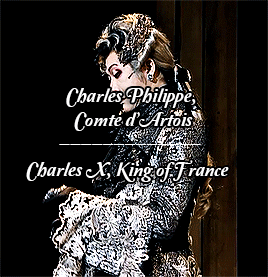





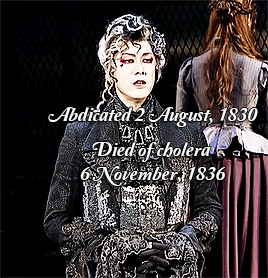
Gif Request Meme - A Musical of my Choice + a Villain: Artois and Orléans
↳ Requested by @fallenidol-453
Philippe Égalité: The only legitimate son of the Duc d’Orléans, a prince du sang from birth, Philippe was a very unlikely revolutionary. And yet Philippe showed a strong level of compassion for the lives of the lower class, going down a coal shaft to see the conditions faced by miners, pulling a groom of his from a river with his own hands, and providing shelter for the poor during the bitter winter of 1788-89.
He was noted for his extravagant lifestyle; a noted lover of racehorses, gambling, architecture, his various and assorted mistresses, and all things English. Despite being the richest man in France, with a truly astronomical income, he nonetheless found himself frequently in debt. That was the impetus for him to totally redesign the Palais Royal over the course of two and a half years, opening it up to shopkeepers and establishing it as a major area for counter revolutionary activity, with the police being banned from intervening. As such, an overwhelming feeling of liberty prevailed there, with people from all social classes gathering to observe the spectacles and walk along the gardens there.
There was a certain amount of hostility to be expected between the two branches of the Bourbon family, going as far back as the first Duc’s tempestuous relationship with his brother, Louis XIV. Still, the relationship between Louis XVI and Philippe gradually deteriorated over time, despite several attempts to patch things up. Orléans blamed Louis for the loss of his naval career, with the controversial Battle of Ushant in 1778 being a major breaking point in their relationship. In 1788, he spoke up at a “Royal Sitting” where Louis tried to press the Parliament into obeying his will, saying “Sire, this appears to be illegal.” Louis responded, “It is legal, because I wish it to be so.” Orléans spent the next five months in a comfortable exile at his estate, and he returned more popular than ever.
When the Estates General was called, Orléans sided with the Third Estate, taking his place with the other delegates rather than sitting with the Royal Family as his rank entitled him to. His name was consistently brought up alongside revolutionary activity, with his bust being paraded alongside Necker’s on July 12, 1789, when the rash charge of the Prince de Lambesc into the Tuilleries heightened the people’s fears over an armed crackdown of Paris. It would be in the Palais Royal where Camille Desmoulins would jump on a table and call the people to arms, and even though the exact impact of that statement’s been disputed, the fact that Palais Royal was a huge locus point for revolutionary activity never has been.
Among the royalists, it was popularly thought that Orléans was behind the entire Revolution, masterminding the Storming of the Bastille, the Women’s March to Versailles, a famine, and various and assorted other disturbances, in lieu of believing that the common people themselves were discontent. However, the sources nearest and dearest to Philippe suggest that he had no intention of seizing power, and Philippe’s own action of going and staying in England at Lafayette’s suggestion between October 1789 and July 1790, when he had a strong chance of fighting back against the charges and seizing power for himself by riding off the highest point of his popularity, strongly indicates that he had no intention of seizing the throne for himself. Overall, while he was a man of undeniable courage, the popular consensus is that he was, by nature, too passive to do it on his own, generally being very diffident to those near him such as his former mistress and longtime friend, Madame de Genlis, as well as her rival for his attention, Pierre Ambroise François Choderlos de Laclos, and generally disinterested in long-form plans, preferring to throw himself into whims. It is far more likely that, if a plan existed to make Philippe king, it came from one of those brains, as opposed to anything Philippe himself considered in any detail.
He did, however, become embittered over the increasingly chilly reception he received at Versailles, including one occasion where a courtier shouted “Do not let him touch the wine!” when he entered, with him then being spat on as he made his leave.
In the latter half of 1792, Philippe faced a bevy of problems, both personal and political, as his long-suffering wife had filed for a separation, his daughter was put on a list of émigrés and was forced to leave the country very shortly after arriving (after Madame de Genlis, who he had instructed to take her back before her name could be added, lingered for too long, causing a final breakdown in their long relationship), his popularity was rapidly fading, and he had been called, as a Deputy of the National Convention, to sit at the trial of his cousin. According to one anecdote, found in William Cooke Taylor’s Memoirs of the House of Orléans, it was in that particular maelstrom that he changed his name, as a last ditch effort to save his daughter and prove his loyalty to the Revolution, to Philippe Égalité. Many options were considered for him to not sit the trial, and there is no reason to believe, despite the long-lasting enmity that the two of them had, that Philippe, when he went to sleep the night before the trial of Louis began on December 26, that he had any idea that when it came time to give the verdict on January 14-15, he would vote “yea,” a decision that shocked the entire room, not the least Louis himself. Perhaps it was a last ditch effort to save himself, perhaps he felt pressured to do it by everyone else in the room, perhaps in that moment he truly believed that Louis’ actions merited the death penalty. It’s impossible to truly know, but in the end that one decision, more than anything else, has defined his legacy.
However, the Royalists would soon be able to find some comfort, as, on the 4th of April 1793, his son, Louis-Philippe, Duc de Chartres, defected along with General Dumouriez, and Philippe’s enemies had the ammunition they needed.
On 7 April, 1793, he was arrested and sent to Fort Saint-Jean in Marseilles, along with two of his sons. Throughout his imprisonment, Philippe kept up an optimistic front, constantly reassuring his sons, the Duc de Montpensier and the Comte de Beaujolais, on the rare occasions he was allowed to speak to them after they were separated, that everything would turn out well, even expressing optimism about his trial in Paris. Whether this was real or simply an attempt at keeping up morale will never be known, but on November 2, 1793, he was sent back to Paris, to be imprisoned in the Conciergerie. He was tried on the 6th and, at his own request not to prolong things any longer than necessary, he was executed on that same day. By all accounts, he met his death courageously, his composure only threatening to break when the cart he was in stopped in front of the Palais Royal, so that he could very clearly see the sign on it that said it was now national property. His last words were to stop the assistants at the guillotine from taking off his boots, saying “You are losing time, you can take them off at a greater leisure when I am dead.”
Unlike his royal cousins, his body was never found, and to this day, he is generally considered as one of the great villains of the Revolution in media associated with it, though none of the serious charges against him (the October Days being prime) were ever proven.
Charles X- For most of his younger years, like his older cousin, Charles’ defining quality was his wild life, which was punctuated by multiple love affairs, copious gambling and alcohol, and even more copious debts, with his brother, Louis XVI, somewhat reluctantly paying the bills. He also had a close friendship with his brother’s wife, who he shared a love of high living with, the two of them often being seen together at the theatre and balls. This close friendship was much remarked upon, with Artois being a frequent subject of the pornographic pamphlets that circulated about the queen, along with Marie Antoinette’s favorite, Madame de Polignac. In the years preceding and following the Revolution, however, the two of them gradually cooled, with their later relationship being marked by political disagreements. Charles consistently pressured his brother into more conservative stances during the meeting of the Estates General, arguing against doubling the Third Estates’ representation and conspiring to get rid of Louis’ liberal finance minister, Jacques Necker. The dismissal of the Necker would end up being one of the leading causes for the Storming of the Bastille, with Charles’ temporary personal victory being quickly eclipsed by the blaze that the little spark of Revolution had turned into. In the days immediately following the Storming of the Bastille, Artois was ordered to emigrate by his brother, along with the rest of his family.
He wouldn’t see France again for decades, going from court to court in Europe asking for help and trailed by a small army of creditors (who would become some of his most frequent companions, the avid huntsman only being able to go out riding at his estate at Holyrood on Sundays, when his creditors would be unable to pursue him), but with very little materializing, even less of which was successful, with the Battle of Quiberon being particularly disastrous to any hope of a royalist win by military might. Instead, he set up his main residence in London, with his mistress, Louise de Polastron, sister-in-law of Madame de Polignac, upon whose death he swore a vow of celibacy, the former playboy becoming sober and religious in his later years. The family briefly returned to France in May 1814, with the exile of Napoleon to Elba, however his later escape and mustering of the troops led to them leaving the city in February 1815, only able to fully establish themselves back in the country shortly after Napoleon’s defeat at Waterloo. Upon his brother, the Comte de Provence’s ascension to the throne as Louis XVIII (the space between XVI and XVIII being taken up by Charles’ young nephew, Louis-Charles, who died in prison and therefore never ruled), Charles became known as a leading member of the Ultra Royalist faction, who were, as the name suggests, “More Royalist than the king.” His brother dying without a male heir, Charles took the throne in 1824, though his highly conservative policies following his more tolerant brother’s reign made him highly unpopular with the public.
In 1830, he was forced to abdicate. His intent had been for the throne to go to his young grandson, however, it would go to Louis-Philippe, Duc d’Orléans, the son of Philippe Égalite (who would himself end up being deposed.) He spent the remainder of his life similarly to how he spent his exile, traveling from place to place, hounded by debtors.
Eventually, he would die in Austria, on 6 November 1836, 43 years to the day of his revolutionary cousin’s execution.
Sources:
The Chevalier de Saint-Georges: Virtuoso of the Sword and the Bow: Gabriel Banat
A French King at Holyrood: Alexander John Mackenzie Stuart
The Journalists and the July Revolution in France: The Role of the Political Press in the Overthrow of the Bourbon Restoration 1827–1830: Daniel Rader
Memoirs of the House of Orléans: William Cooke Taylor
The Perilous Crown: France Between Revolutions, 1814-1848: Munro Price
Prince of the blood : being an account of the illustrious birth, the strange life and the horrible death of Louis-Philippe Joseph, fifth duke of Orleans, better remembered as Philippe Egalite: Evart Seelye Scudder
Revolutions in the Western World 1775–1825: Jeremy Black, ed.
#perioddramaedit#asiantheatrenet#musicaltheatreedit#historyedit#1789 les amants de la bastille#marie antoinette das musical#keigo yoshino#mitsuo yoshihara#long post#ch: artois#Production: Toho#other musicals: MA#historical#on this day in history we mourn the death of two thots#one more than the other#(apologies if I smudged any facts given that it is rather late)
65 notes
·
View notes
Text
Virtual Visit: Vaux-le-Vicomte

Last spring I wrote a series of posts about virtually visiting fandom filming locations for a Travel Writing class, and since November 16th is considered "International Versailles Day" within the Versailles fandom (to commemorate the first episode airing in 2015), I thought I would re-create the post here. This virtual tour, as well as a few others, will be a part of my Capstone project to be completed next year. Enjoy!
The Chateau Vaux-le-Vicomte has been used in many period pieces, but the one I am focusing on for this post is the television series Versailles. The show ran for three glorious seasons (2015-2018) and in my opinion could have gone for another three no problem. Life in Louis XIV’s Court was filled with enough intrigue and decadence to put a modern day soap opera to shame. While the show takes some liberties, as they all do, much of what you see as the drama plays out on the screen is true. I fell down the research well after discovering the show and I think sometimes the writers actually hold back when portraying the utterly elegant madness of the time of Louis XIV’s Versailles.
Vaux itself is never mentioned by name in the show, but it stood in for many scenes that were supposed to take place within the real palace of Versailles. In the header picture it is doubling for Saint-Cloud, the royal residence of Philippe d'Orleans (1640-1701), the only brother of King Louis XIV (1638-1715). The actual Saint-Cloud no longer exists, but it is said that the beauty of Philippe's chateau rivaled Versailles' in the opinion of many visitors at the time. A fact that did not please the King.

A quick history lesson
You cannot talk about Vaux-le-Vicomte without also looking at Nicholas Fouquet (1615-1680) from whose mind the chateau sprung. Though less like Athena from Zeus because it took 20 years for Fouquet’s dream to come to fruition.

In 1641 he acquired the land and proceeded to demolish the existing chateau and cleared the village of Vaux and two adjacent hamlets. The three men who were behind the stunning beauty of the chateau and gardens were the architect Louis Le Vau (1612-1670), gardener André Le Nôtre (1613-1700), and painter and decorator Charles Le Brun (1619-1690). Thanks to the support of Fouquet, each of these men, already respected in their fields, would create an architectural, artistic and design legacy that would influence all of Europe.
Le Veu designed a chateau that worked with the gardens to enhance their beauty equally. Le Nôtre used new techniques in gardening along with his own unique designs to create the original French formal garden. Le Brun was the genius behind the lavish artwork inside the chateau, filled with mythology and allegorical figures that were characteristic of the 17th century.
Later, all three of these men would work under the direction of Louis XIV as he created his own masterpiece, Versailles, which was influenced heavily by Vaux. You see, when Nicholas Fouquet, then the Minister of Finance, held the first grand party in 1661 to showcase the completed chateau for the king, that’s when it all fell apart. He had apparently gone too far, and dreamed too big.
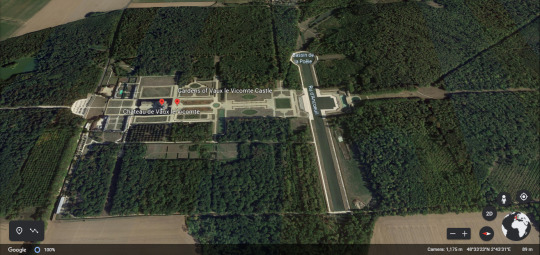
The writer Voltaire wrote, “On 17 August, at 6 o’clock in the evening, Fouquet was king of France; at 2 o’clock in the morning, he was nothing.” It didn’t happen quite that fast, but three weeks later Fouquet was arrested by d’Artagnan, of the King’s Musketeers, and accused of embezzling from the Crown. In reality, it had been the Cardinal Mazarin who had depleted the royal coffers, but it didn’t matter. Fouquet was sent to prison in Pignerol, where he died in 1680.
The King claimed much of the chateau's assets and auctioned off the rest. Madame Fouquet left the chateau and gardens to her son, but the domain was sold to the Marshal of Villars in 1805 after the son’s death. It was briefly renamed Vaux-Villars until after the Marshal's death when his son sold it to the Duke of Praslin. The chateau was a place of pride for the Duke, and while six generations of his family called Vaux home, maintaining the chateau and gardens simply became too expensive.
For 30 years Vaux-le-Vicomte was left empty and neglected until 1875 when Alfred Sommier purchased it at auction and began to bring the masterpiece back to life. Today, the chateau and gardens are managed by Jean-Charles and Alexander Vogué, the fifth generation in the family to do so.

What it means to me
I wish it could be possible for every film or television show to be filmed on-location, but time, space and money are always a factor. In the case of using Vaux-le-Vicomte for many scenes to represent the palace of Versailles it was not just because Versailles is only closed to the public on Mondays but also because the interior of the palace has changed drastically since the time of Louis XIV, unlike Vaux-le-Vicomte.

And so many iconic scenes were filmed here, such as when Louis XIV (George Blagdon) feverishly dances in the Grand Salon to the shock of the nobles watching, and the horror of his valet Bontemps (Stuart Bowman) who quickly has the windows and doors closed against prying eyes.
The love Bontemps feels for his King is perfectly portrayed, while the scene also shows how untouchable the King is. No one dares approach the King, not even his guards, when it is obvious there is something wrong. The nobles might be titillated by the odd display, but they keep safely outside of the salon and just watch. Only Bontemps is allowed to take control of the situation.
Historically, the fever that brought him close to death, and made the possibility of his brother (portrayed by Alexander Vlahos in the show) taking the throne, happened before the work on Versailles had begun, but it fits well within the Versailles season one plotline.
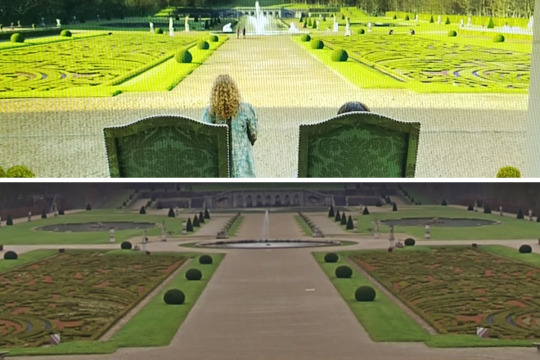
I loved that Saint-Cloud was represented, the facade at least, by Vaux-le-Vicomte because, as I mentioned, the original chateau was destroyed. In the show, the brother of the King does not have an easy time of it, similar to what we know of his life historically. That the chateau Philippe loved so dearly and put a lifetime of work into was destroyed just seems a tragic loss for history and for the man who is known as the grandfather of Europe. After all, it is his progeny who lived to become royalty in nearly all of Europe even to today, and not King Louis XIV's.

Best way to virtually visit
We are very lucky that Vaux-le-Vicomte partnered with Google to create a virtual tour experience of many rooms in the chateau as well as the formal gardens. For the long way around, go to:
Vaux-le-Vicomte website (you have the option to choose from several languages)
Scroll down and click “Multimedia”
Click “Virtual Tour”
Click “Google Street View” to go directly to the virtual tour options
Scroll down to see the two icons for the chateau or Gardens
Pick your choice
Or just use this link for the Google Arts & Culture page, scroll down and find the Virtual Tour icons.
I listed the longer way first because the Vaux website has so much wonderful information to explore before or after taking the virtual tour that it’s worth taking the long way around.
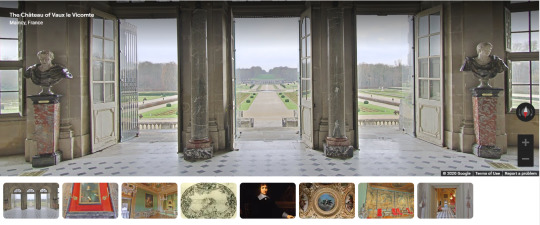
The Chateau option starts off in the Grand Salon. From there you can move around using the arrows or go directly into different rooms using the thumbnails at the bottom of the screen.
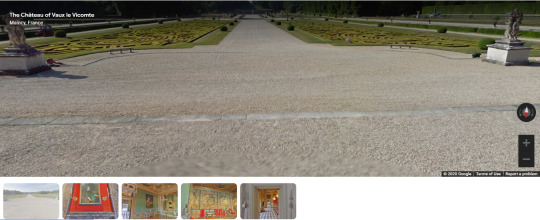
The Garden option drops you outside of the chateau. While you cannot move straight down the wide path, you can move left or right to continue forward along the side paths. The cool thing about this virtual tour? You can “walk” from the chateau all the way up the hill to the Hercules statue and look back down. (Note: The current Hercules statue is actually a 19th century copy of the original.)

I think this tour has made me want to visit in-person in ways few other virtual tours have, and at this point I have explored quite a few! I want to walk every inch of those garden paths even if my feet complain! And I want to take a guided tour of the chateau to hear about the incredible history and maybe get a few details only someone familiar with the history can reveal!
Thank you Vaux-le-Vicomte and Google!
You can watch all three seasons of Versailles on Netflix.
Source for the historical background of Vaux: the Vaux-le-Vicomte website
Other Sources: Personal screenshots, Google Earth, Wikipedia
Posted: November 16, 2020
1 note
·
View note
Text
First New Marvel X-Men Crossover Revealed
https://ift.tt/eA8V8J
Marvel announced the first major crossover of Jonathan Hickman’s Dawn of X era of X-Men. X of Swords will tie all the X-titles together in a ’90s throwback, 15-part crossover touching every single book in the line.
“One of the cool things we are able to do now, because we’ve established the X-line and really know where we’re going, is that we’re able to try some different things out,” Hickman said in a statement. “X of Swords will be an old school crossover that meanders through the entire line. It’s almost like chapters of a story.”
Hickman, you’ll recall, reinvigorated the X-Men line with House of X and Powers of X. And like Powers of X, X of Swords is using the Roman numeral X as a sort of low-nerdy double entendre. Where Powers of X examined four time periods of exponential scales, X of Swords heavily implies a focus on the mystical (the Ten of Swords is a not great tarot card – it depicts a man lying face down on the ground with ten swords in his back), and the promotional artwork seems to hint at that being the case.
As he did for HoX/PoX, Mark Brooks drew a pretty interesting promotional piece for X of Swords. Take a look, but be warned: Past the picture, there will be spoilers for most Dawn of X comics, as we try and look at who’s on the piece, and almost as importantly, what swords they’re holding.
Starting in the top left corner and moving clockwise:
Eye Boy, created for Jason Aaron’s underrated Wolverine and the X-Men and slated to appear as part of Leah Williams’ and David Baldeon’s X-Factor. That book has Trevor as a part of the team that investigates mutant deaths so the resurrection protocols can be initiated. He’s wielding some kind of eye sword.
Gorgon, the ex-Hand leader who once killed, resurrected and brainwashed Wolverine into being a Hand agent. Since joining the mutants on Krakoa, Gorgon was personally recommended by Logan to be one of the four Great Captains of Krakoa, responsible for the protection of the mutant ruling council when they leave the island. He’s holding the Godkiller sword that he’s carried since he was in Hickman’s Secret Warriors. The blade was created for Zeus but lost, and eventually made its way into Gorgon’s hands.
Next to him is John Greycrow, formerly one of Sinister’s Marauders, and slated to be a member of Hellions, an upcoming book from Zeb Wells and Stephen Segovia. Greycrow is a master marksman who honed his talents in war (originally World War II, but Marvel Time means his service dates have been moved up to Symkaria or something) and has technology powers. He’s carrying some kind of technological gunsword.
Below and to the right is Brian Braddock, formerly Captain Britain but now titleless (I believe) after ceding the Amulet of Right to his sister Betsy in Tini Howard and Marcus To’s magnificent Excalibur. He’s holding the Sword of Might, one of the two artifacts offered to potential Captains Britain. When captured and corrupted in Otherworld by Morgan Le Fay, Brian gave up the Amulet of Right to Betsy to help her stop Le Fay’s attack. He’s currently suffering through a crisis of confidence now that he’s left with only the sword. It also feels important that he’s textually not a mutant.
Below Captain Britain is Psylocke. This will stop being confusing in a couple of months – Kwannon (the woman who was body-swapped with Elizabeth Braddock back in the late ‘80s, then died of the Legacy Virus in Betsy’s old body) was resurrected during Wolverine’s return before HoXPoX. She was most recently in Fallen Angels running down ex-family and trying to kill Apoth, a self-aware AI drug dealer. Psylocke is carrying a fairly standard-looking sword.
Above him is Rachel Grey, another member of X-Factor, carrying the Blade of the Phoenix, the Shi’ar sword used by the Death Commandos to wipe out her bloodline on Earth.
Below her is Charles Xavier, carrying the sword Magneto made for him out of the broken shards of the Cerebro helmet he was wearing when he was shot in the head in the pages of X-Force.
Next to him is Cable carrying a sword I recognize but can’t name at the moment. Cable is set to appear in his own book, from Gerry Duggan and Phil Noto, but has spent much of Dawn of X on family vacations with Cyclops, Jean Grey, Rachel Grey, his uncle Gabe, his dad’s boyfriend Wolverine, his dad’s other wife Emma Frost, and their island home’s estranged sister.
Above Cable is Doug Ramsey, Cypher. Doug was most recently running around Shi’ar territory trying to get to Chandilar to visit with Cannonball in Hickman and Rod Reis’ New Mutants. He’s back on Earth and back to functioning as Krakoa’s voice now. The sword he’s carrying looks like it’s a techno-organic extension of his arm, but it could also be his best friend, Warlock the Technarch, hiding from Cyclops. Confused? Go read X-Men #7.
Next to Cable and Cypher is Betsy Braddock, the newest Captain Britain. She is attacking with her telekinetic sword that’s a manifestation of her powers, and she’s dressed in her snazzy new Captain Britain uniform designed by To for Excalibur.
Next to Betsy is a yet-unnamed sidekick to Angel who’s set to appear in Vita Ayala and Bernard Chang’s Children of the Atom, starting in April.
Read more
Comics
X-Men: Who are the Children of the Vault?
By Jim Dandy
Movies
Marvel Movies Release Schedule: Complete MCU Phase 4 Timeline
By Mike Cecchini
Down and to his right is Domino, sporting a fancy wooden stabbing sleeve crafted by Forge to heal the parts of her that were skinned by the Reavers to allow them to pass undetected through Krakoa’s defenses in early X-Force.
Below her is Cyclops with a laser sword. You don’t need much more than that.
In the bottom right corner is Armor, Hisako Ichiki. She debuted in Joss Whedon and John Cassaday’s Astonishing X-Men, and has been a leader of that era of students since. She’s currently spreading the good word about Krakoa to mutants around the world in the pages of New Mutants.
To the left is Wolverine carrying the Muramasa blade. This sword cuts through anything and disrupts healing factors – it’s one of the few things that could potentially hurt Wolverine enough to kill him.
Next to Logan is Magik, Ilyanna Rasputin, carrying her Soulsword. More on this in a second, but Magik has most recently been in space with Cypher and the rest of the New Mutants, in her case trying to make out with all of the Shi’ar Death Commandos.
To Magik’s side is Storm carrying some kind of long lightning kunai.This is one of my favorite sentences of all time.
Below Storm is Nightcrawler, the first Pope of a new mutant religion (again, read X-Men #7, it’s bonkers) carrying a fancy looking rapier. Nightcrawler has always been modeled (and modeled himself) after Errol Flynn, and the rapier is a big part of that.
Next to Nightcrawler is Storm’s Marauders teammate Iceman, ready for some Stabbing…and…Chill…? I’m sorry, once I thought of it I had to type it.
And finally, above Iceman is Apocalypse, the man who ended the Bronze Age. Apocalypse is pictured here holding one of the jagged scimitars he was last seen carrying in a flashback told by Cypher about Krakoa’s ancient history. Krakoa was once Okkara, one big island, until an invasion from another plane forced Apocalypse to sacrifice his first Horsemen to seal off that invasion, and half of Okkara. Arrako, the sealed off sister island to Krakoa, reappeared in X-Men #2, and with it the daughter of one of the Horsemen.
This was one of the most exciting dangling ideas from House of X and Powers of X. The fact that Dawn of X has been just as casually stuffed with new concepts and deep examinations of the changes wrought by Krakoa and the Five’s resurrection abilities, while also making time for fun superhero punch ups and picking up ideas that have been left on the ground by the introductory series is what’s making the X-Men line so exciting right now.
cnx.cmd.push(function() { cnx({ playerId: "106e33c0-3911-473c-b599-b1426db57530" }).render("0270c398a82f44f49c23c16122516796"); });
X of Swords kicks off in July.
The post First New Marvel X-Men Crossover Revealed appeared first on Den of Geek.
from Comics – Den of Geek https://ift.tt/2vwtL5e
0 notes